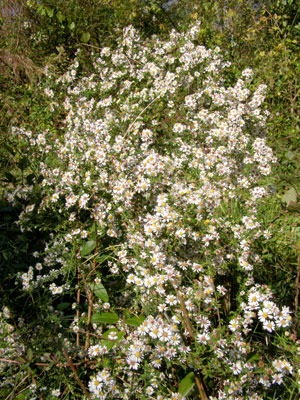More than “peakâ€
Ken Moore
Flora Columnist
Exploring my favorite power line right-of-ways last Saturday, still chasing after the elusive “peak†of fall color, I was surprised to find colorful wildflowers following the recent frosts.
Flowering since mid-September, one of my favorite fall flowers is frost aster, Aster pilosus, more correctly, Symphyotrichum pilosum. Its white-flowered stems are scattered freely about my yard and vigorous clumps, appearing like tiny shrubs, are still evident along rural roadsides.
Chapel Hill resident Mickey Jo Sorrel selected frost aster to study as her project for the N.C. Botanical Garden’s fall flora class. The class projects included a challenge to define the selected native plant with a haiku. Mickey Jo’s haiku shows that she truly understands the plant.
Scraggly, nondescript,
But the meek shall inherit.
Must resist weeding.
Beginning as a winter basal rosette of “scraggly, nondescript†leaves, Mickey Jo does “resist weeding†it from her garden, knowing in advance that “the meek shall inherit.†Common frost aster thrives throughout the challenging growing season to dominate entire fields in the fall with a layer of snow-white flowers, appearing like frost on chilly mornings. Mickey Jo likes to make certain she always has some in her garden.
Make note here not to confuse diminutive frost asters with the eye-catching sea myrtle, Baccharis halimifolia. This large shrub has suddenly burst onto the roadside scene with billowy masses of white. (See Flora: “A Plant that’s on the move,†Nov. 8, 2007) We are not seeing flowers; we are seeing masses of white seed heads, each tiny seed bearing little white plumes awaiting a wind for transport to faraway destinations.
This plant of the coastal salt marshes was not so locally common three decades ago. Now it is aggressively invading roadsides and other disturbed areas at an alarming rate. Travelers to and from coastal areas have helped spread this opportunistic plant inland along highway corridors. Once established, it’s almost impossible for other native plants to become established.
Now back to my recent power-line adventure: More impressive to me than the late flowering of the asters was the diversity of pollinating insects. One would have thought the recent freezes would have eliminated this year’s populations.
While taking a closer look at brilliant violet-hued, big-flowered asters, Aster grandiflorus (still not used to the new name, Symphyotrichum grandiflorum), I counted no fewer than six different insects vigorously visiting the flower heads.
Among the visiting insects were solitary bee, honeybee, thread-waisted wasp and a common buckeye butterfly. The buckeye is reported to be migrating south because it can’t survive freezing temperatures. Well now, this one has survived, though it did appear to have had several rough nights. It was quite lively in the afternoon sun however, and the experience made me pause to marvel at the perfectly aligned seasonal cycles of flowers and their partner insects. I wonder if those same insects find shelter among the flowers that visit.
Whether or not you have a favorite power line to walk, there’s still time to get out for fall color with flower and insect surprises along the way.
Email Ken Moore at flora@carrborocitizen.com. Find previous Ken Moore Citizen columns at The Annotated Flora.




Comments are closed.